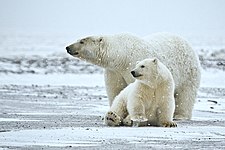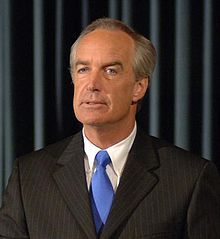US says polar bears are threatened species
Wednesday, May 14, 2008

Image: Alan D. Wilson.
The United States Department of the Interior today listed the polar bear as a threatened species under the Endangered Species Act (ESA), due to the melting of Arctic sea ice that is the bears' habitat. The announcement of the listing was made by Interior Secretary Dirk Kempthorne.
In making the announcement, Kempthorne said he wishes to prevent further losses of polar bears, but he warned against using the Endangered Species Act to "regulate greenhouse gas emissions from automobiles, power plants, and other sources", which he called "a wholly inappropriate use of the ESA law."
Kempthorne says the Interior Department will apply separate rules from the Marine Mammal Protection Act to the polar bear, which will permit flexibility in economic development as long as the survival of the species is not adversely affected. Kempthorne said the policies "will ensure the protection of the bear while allowing us to continue to develop our natural resources in the Arctic region in an environmentally sound way."

The Government of Nunavut fears the decision could lead to a ban on the importation of polar bear hides into the United States. As a result the Nunavut economy could suffer. The polar bear hunt generates $1.5 million (US) per year in revenue.
Carl Pope, director of the environmentalist Sierra Club, criticized the Interior Department's decision, saying it was "riddled with loopholes, caveats and backhanded language that could actually undermine protections for the polar bear and other species".
The government was forced to make a decision regarding the polar bear by May 15, after environmental groups sued the George W. Bush administration for failing to meet a January 9 deadline. The administration was accused of postponing the decision as a way to allow for more Alaskan oil and gas drilling.
The purpose of the Endangered Species Act is to protect species that may be in danger of extinction as a result of human action. It aims to achieve this by regulating federal activity in the habitat of threatened species. Commercial activity is not directly regulated, but companies must receive a permit for development in designated habitats.
The polar bear is the first animal to be protected under the Endangered Species Act due to the threat that global warming poses to the bears' Arctic habitat. Some environmental groups say they could use the designation to protest the construction of coal power plants located thousands of miles away from the Arctic, which they blame for contributing to greenhouse gases and global warming.
However, Barton H. Thompson Jr., a law professor at Stanford University, says that such lawsuits would be difficult to win. "Interior has a reasonable case here that the connection [between greenhouse gas emmissions and polar bears] is just too far removed," he says.
If sea ice continues to melt, two-thirds of the polar bear population could be gone by 2050, according to studies released by the United States Geological Survey last September. Also, Louis Fortier of the Canadian research group ArcticNet believes the Arctic Ocean could be ice-free in the summers by 2010.
But M. Reed Hopper of the Pacific Legal Foundation, a property-rights group, disputes the notion that the polar bear is severely threatened. He says the government used "speculative computer modeling" to make its decision, and he plans to sue the Interior Department. "Never before has a thriving species been listed under the Environmental Species Act, nor should it be," he said.
Related news
- "NASA: Old Arctic sea ice continues to melt" — Wikinews, March 18, 2008
Sources
- "Interior’s Kempthorne: Protect Bears, Prevent Harm to Economy" — The Wall Street Journal, May 14, 2008
- Marsha Walton. "Polar bear now listed as 'threatened' species" — CNN, May 14, 2008
- Adam Satariano. "Polar Bear Gets Threatened Status Because of Warming" — Bloomberg L.P., May 14, 2008
- Felicity Barringer. "Polar Bear Is Made a Protected Species" — The New York Times, May 14, 2008
- Elana Schor. "US declares polar bears threatened" — The Guardian, May 14, 2008
- Colin Campbell, Kate Lunau. "The war over the polar bear" — Maclean's, January 25, 2008
- "Hunting and Conservation - a Nordic Perspective" — CIC Wildlife, October 25, 2004


